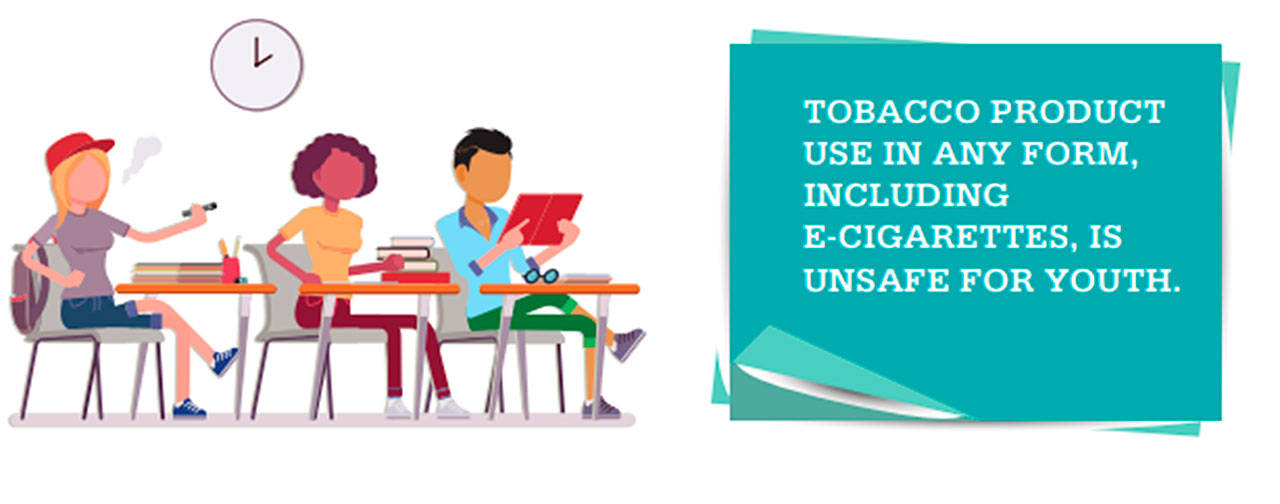The following is written by Carley Thompson for Public Health Insider.
Part Two: Over the next few weeks, in a three-part series of blog posts, we’ll take a deeper dive into the JUULing and vaping epidemic among youth in King County and across the country. We’ll look at what youth are doing in King County, what parents can do to help keep their kids tobacco-free, and how e-cigarette use can lead youth to a lifetime of nicotine dependence.
As we talked about in the first blog in this series, How JUUL Cornered the Youth Tobacco Market and What You Should Know, youth are using e-cigarettes more than any other tobacco product, and when they do, they’re probably using JUUL. In King County, twice as many youth are vaping as are smoking cigarettes – in 2016, 10% of 8th, 10th and 12th graders used e-cigarettes. So, chances are pretty good that your child or children know what vaping is, have seen someone vaping, or have friends or classmates that vape. There’s no question that movies, music and TV affect kids, but research from the CDC tells us that parents actually have the greatest influence when it comes to tobacco use.
No pressure, parents!
We reached out to Lisa Davidson, Prevention and Intervention Manager with Seattle Public Schools, to ask what she recommends parents do, before school starts up again, to help their kids remain tobacco-free. She shared the following:
Before you do anything else, learn about vaping, types of e-cigarettes, and the risks of all forms of e-cigarette use for young people (stay tuned for blog #3 in our series to learn more about youth vaping & their health). One of the most important things parents can do is talk to their kids. Talking to pre-teens and teens is sometimes easier said than done, right?
Here are my tips for talking to your kids about vaping:
Find the time to talk. The sooner you start talking, the better. Bring up the subject when you see it on TV, in movies, or in magazines.
Be direct. Say, “I don’t want you to use e-cigarettes.” Tell them your reasons. They’ll appreciate your honesty and guidance.
Talk about the real facts. Just saying “Vaping is bad for you!” isn’t enough. Young people are more likely to listen if you give them facts. Don’t just talk about e-cigarettes – give them facts about vaping products like JUULs, and other tobacco products such as mini-cigars and hookah.
Focus on the social issues. Young people may care more about getting bad breath or irritating their friends who don’t vape than about the health risks. Help them understand the financial costs as well. Remind them that most teenagers do not use e-cigarettes/vaping products.
Teach them to say no. Help them to think of what to say if they are offered vaping products. Practice with them – pretend you are a classmate asking them to vape. Ask them to come up with several responses and teach them when to walk away. Remember to praise their efforts.
Need more help talking to your kids about vaping? The Escape the Vape campaign hopes to give kids the facts they need to make the decision to stop or never start vaping themselves. Through videos the “Chemical Crew” teaches youth about the potentially harmful chemicals in vape liquid.
Along with sitting down to talk, one of the best things you can do to help your kids remain tobacco-free is to set a positive example by being tobacco-free yourself. If you use tobacco, it’s never too late to quit. Visit our website for resources to help you quit or call Washington’s Tobacco Quitline at 1-800-QUIT-NOW (1-800-784-8669).
More resources:
E-cigarettes and vapor products
E-cigarettes and vapor products CDC
Talk with your teen about e-cigarettes: A tip sheet for parents


